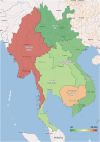Malaria Research for Tailored Control and Elimination Strategies in the Greater Mekong Subregion
- PMID: 36228914
- PMCID: PMC9662225
- DOI: 10.4269/ajtmh.21-1268
Malaria Research for Tailored Control and Elimination Strategies in the Greater Mekong Subregion
Abstract
The malaria landscape in the Greater Mekong Subregion has experienced drastic changes with the ramp-up of the control efforts, revealing formidable challenges that slowed down the progress toward malaria elimination. Problems such as border malaria and cross-border malaria introduction, multidrug resistance in Plasmodium falciparum, the persistence of Plasmodium vivax, the asymptomatic parasite reservoirs, and insecticide resistance in primary vectors require integrated strategies tailored for individual nations in the region. In recognition of these challenges and the need for research, the Southeast Asian International Center of Excellence for Malaria Research has established a network of researchers and stakeholders and conducted basic and translational research to identify existing and emerging problems and develop new countermeasures. The installation of a comprehensive disease and vector surveillance system at sentinel sites in border areas with the implementation of passive/active case detection and cross-sectional surveys allowed timely detection and management of malaria cases, provided updated knowledge for effective vector control measures, and facilitated the efficacy studies of antimalarials. Incorporating sensitive molecular diagnosis to expose the significance of asymptomatic parasite reservoirs for sustaining transmission helped establish the necessary evidence to guide targeted control to eliminate residual transmission. In addition, this program has developed point-of-care diagnostics to monitor the quality of artemisinin combination therapies, delivering the needed information to the drug regulatory authorities to take measures against falsified and substandard antimalarials. To accelerate malaria elimination, this program has actively engaged with stakeholders of all levels, fostered vertical and horizontal collaborations, and enabled the effective dissemination of research findings.
Figures


References
-
- Delacollette C et al. 2009. Malaria trends and challenges in the Greater Mekong subregion. Southeast Asian J Trop Med Public Health 40: 674–691. - PubMed
-
- World Health Organization. Regional Office for the Western Pacific , 2015. Strategy for malaria elimination in the Greater Mekong Subregion: 2015–2030. WHO Regional Office for the Western Pacific. https://apps.who.int/iris/handle/10665/208203.
-
- White NJ , 2010. Artemisinin resistance–the clock is ticking. Lancet 376: 2051–2052. - PubMed
Publication types
MeSH terms
Substances
Grants and funding
LinkOut - more resources
Full Text Sources
Medical

